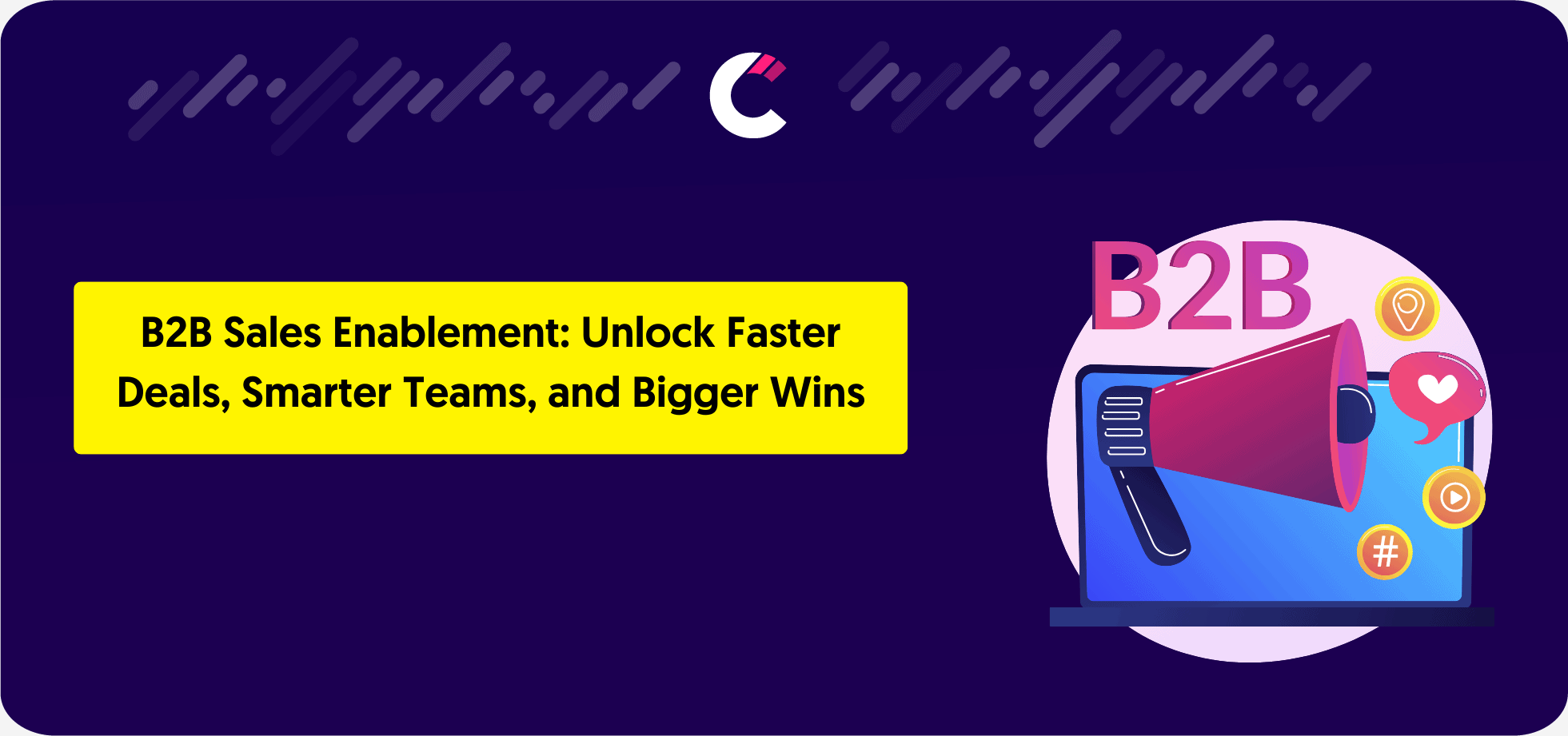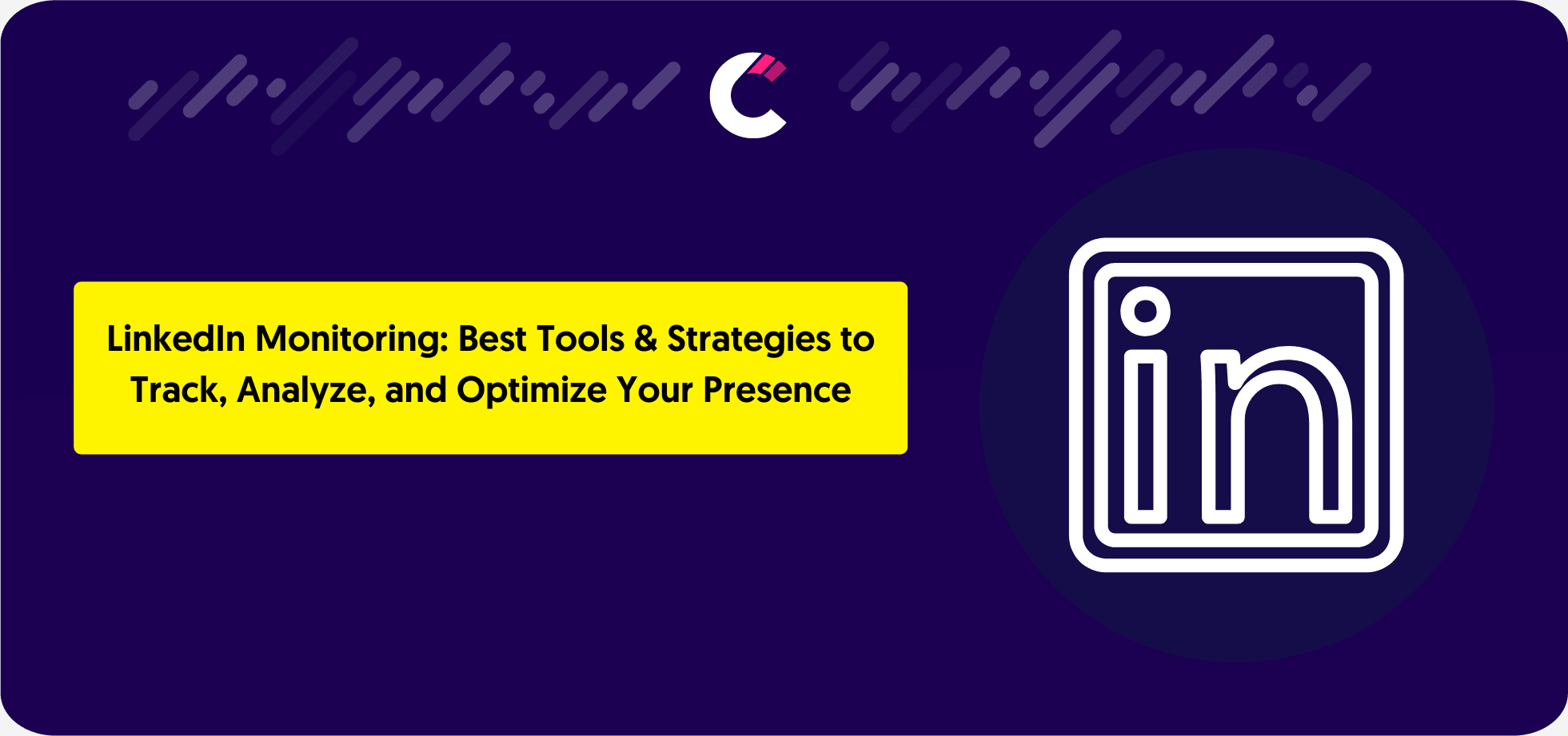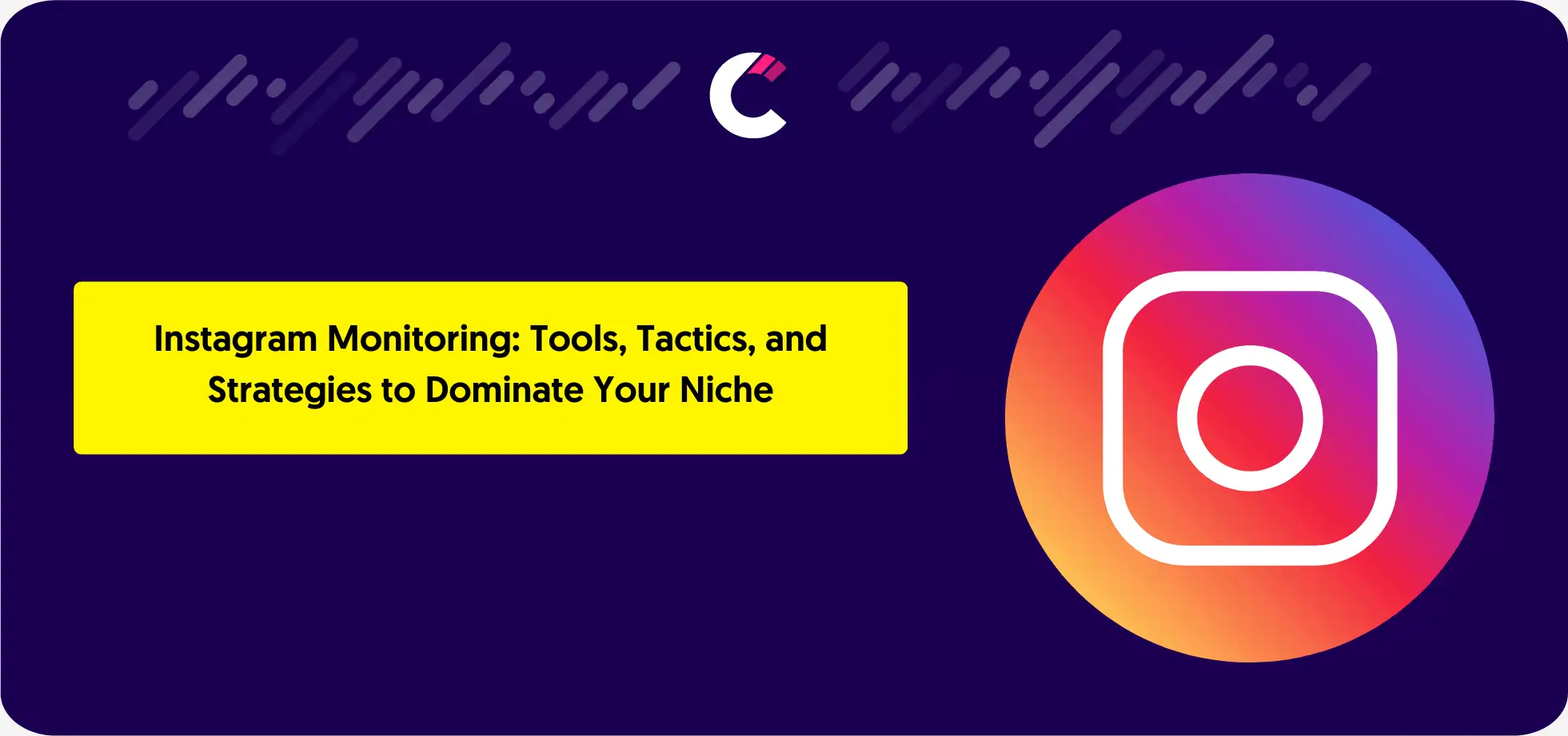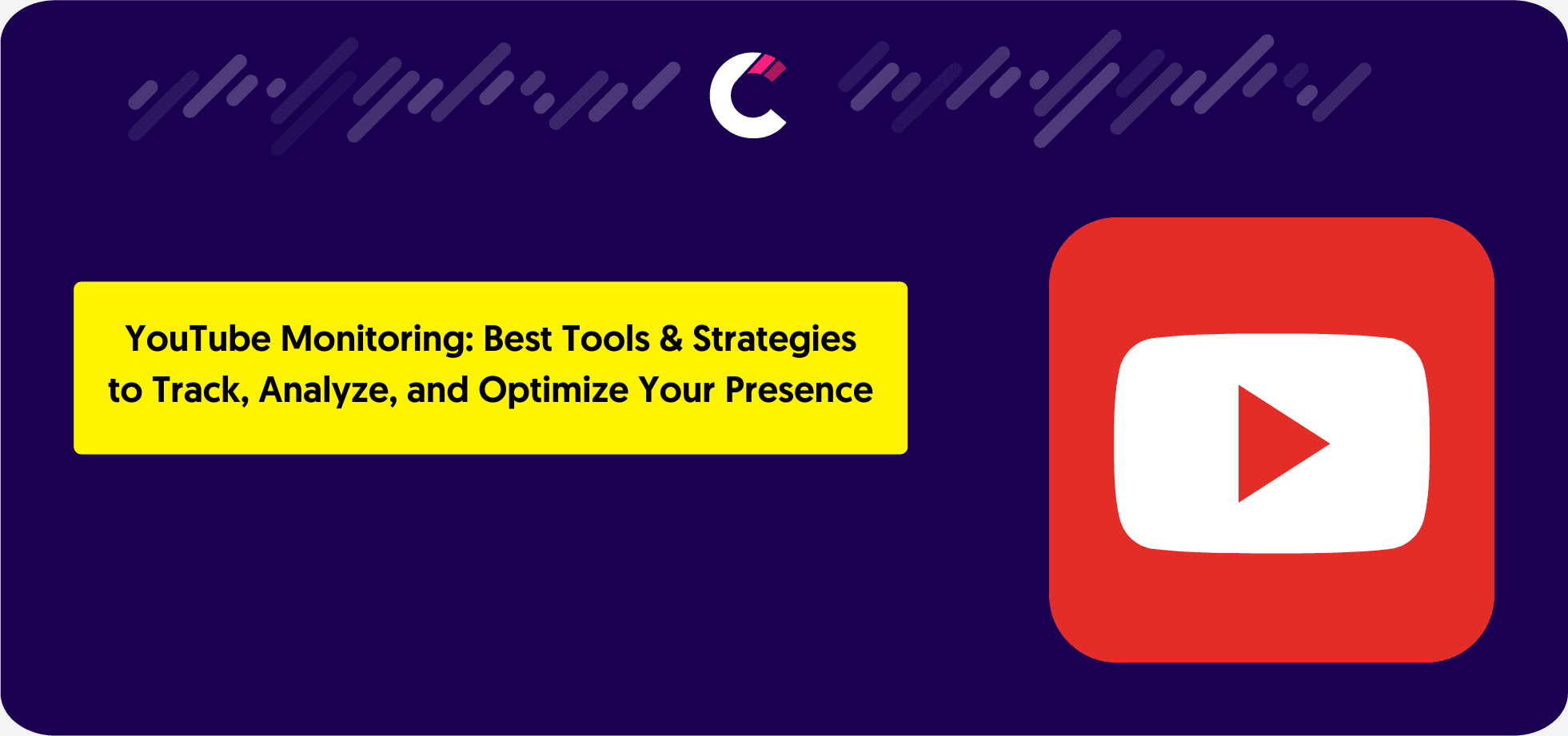What is B2B Sales Enablement?
B2B sales enablement is about giving your sales team the edge they need to close deals confidently. Think of it as a system that aligns sales and marketing while equipping your team with the right tools, insights, and content to handle complex buying decisions.
It’s more than just creating brochures or running training sessions—it’s about ensuring your team is laser-focused on delivering value to prospects at every stage of the sales journey.
Breaking Down B2B Sales Enablement:
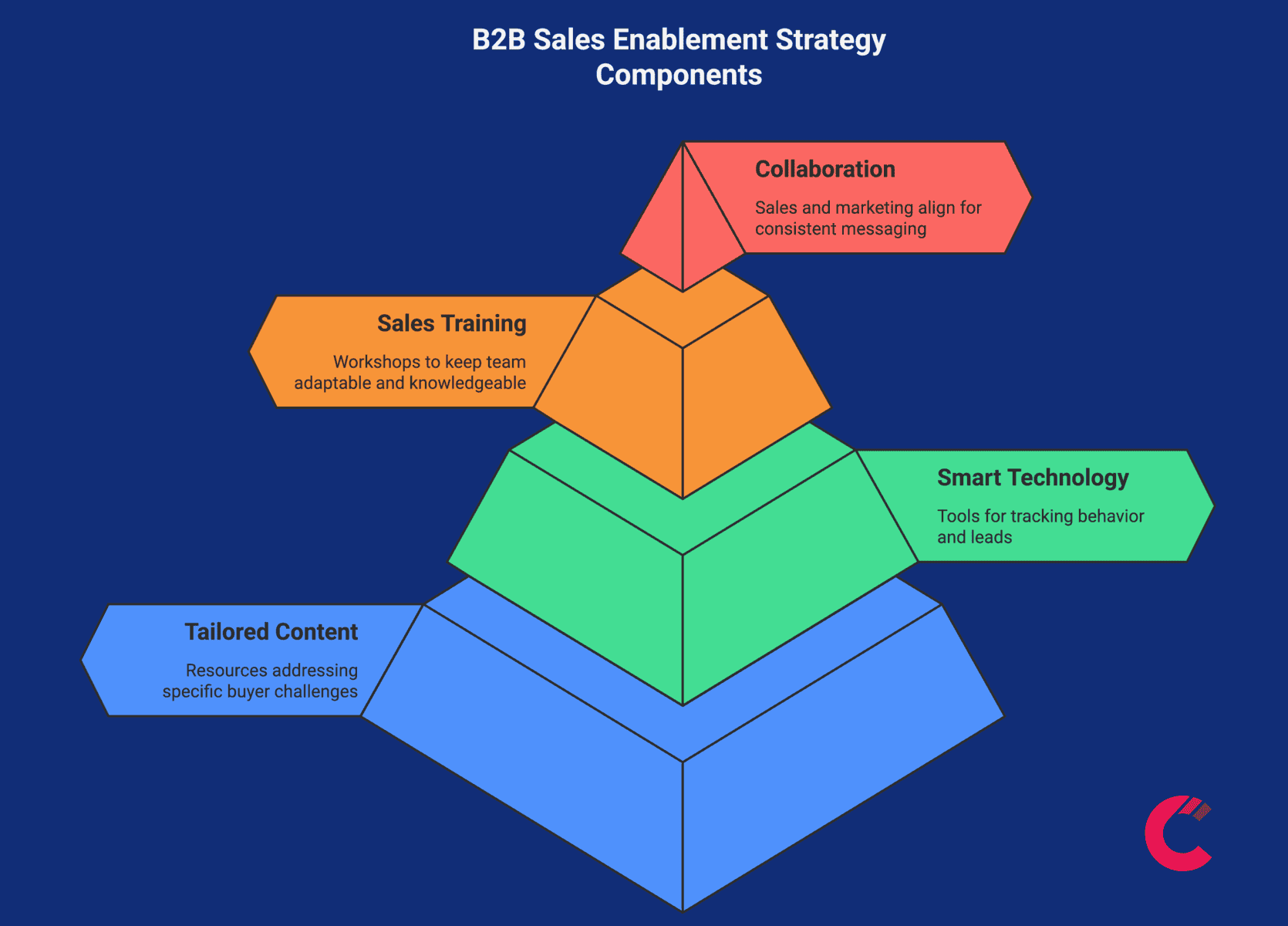
- Tailored Content: Resources like case studies, product comparisons, and industry insights that directly address buyer challenges.
- Smart Technology: Tools like CRM platforms and analytics dashboards that help sales reps track buyer behavior and prioritize leads.
- Sales Training: Regular workshops and coaching sessions to keep your team sharp, knowledgeable, and ready to adapt.
- Collaboration Between Teams: Sales and marketing work hand-in-hand to deliver consistent messaging and drive results.
Why is this so important? In B2B, buying decisions aren’t made on a whim. They involve multiple stakeholders, long decision cycles, and high expectations for personalized solutions. Without a strong business-to-business sales enablement strategy, even the best sales teams risk being outpaced by competitors who are better prepared.
B2B Sales Enablement vs. Other Strategies
B2B sales enablement isn’t just another sales buzzword—it’s a distinct strategy designed to directly support your sales team in closing deals faster and smarter. While other approaches like content marketing and sales operations contribute to the bigger picture, sales enablement focuses on bridging the gap between strategy and execution.
Key Differences:
Content Marketing vs. Sales Enablement
Content marketing is about building awareness—blogs, eBooks, and videos that educate your audience. Sales enablement takes those same materials and ensures they’re actionable for your sales reps. It’s about giving them content tailored to specific buyer stages, so they always have the right message at the right time.
Sales Operations vs. Sales Enablement
Sales operations focuses on the “behind-the-scenes” logistics—like setting quotas or managing territories. Sales enablement, on the other hand, is all about empowering the frontlines: training your sales team, streamlining their workflows, and providing the tools they need to succeed.
Why does this distinction matter? Without a clear B2B sales enablement guide, businesses risk wasting time on strategies that don’t directly drive results.
Enablement makes sure every resource and tool serves a purpose: helping your team close more deals, faster.
The Benefits of B2B Sales Enablement
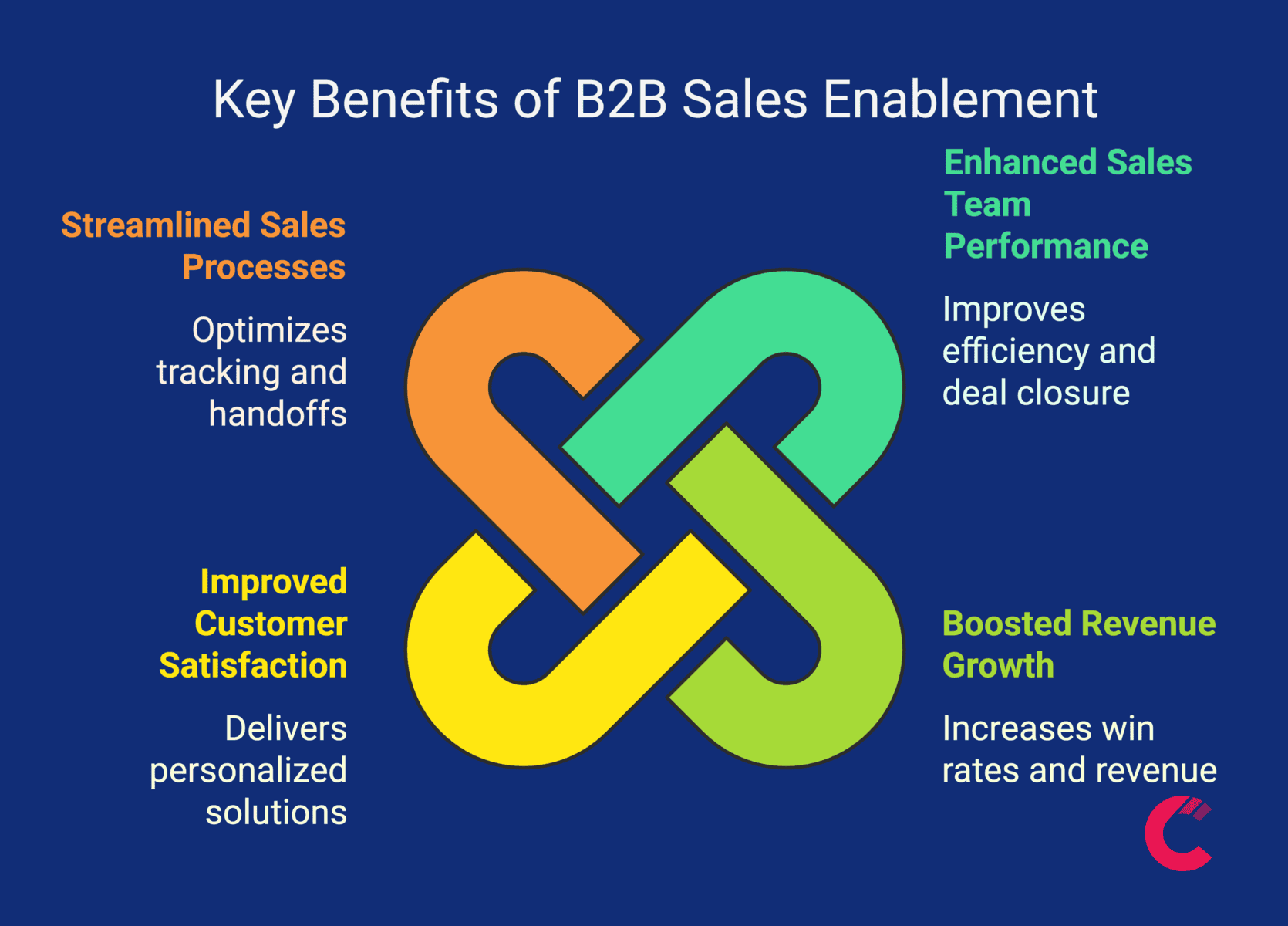
What makes B2B sales enablement such a game-changer? At its heart, it’s about giving your sales team the right tools, resources, and knowledge to sell better. But the impact doesn’t stop there—it ripples across your entire business, from increasing revenue to improving customer relationships.
Enhanced Sales Team Performance
With a clear B2B sales enablement strategy, reps spend less time searching for resources and more time closing deals. Tailored training programs and easy-to-access content mean they’re always ready to tackle buyer objections with confidence.Boosted Revenue Growth
Sales enablement directly supports revenue goals by helping your team target the right prospects and nurture them effectively. Companies with strong enablement practices see up to 27% higher win rates, according to a study by CSO Insights.Improved Customer Satisfaction
Buyers expect personalized solutions, especially in B2B. Sales enablement helps reps deliver just that—whether it’s through customized product demos or well-timed follow-ups. Happy customers often lead to long-term partnerships.Streamlined Sales Processes
Say goodbye to inefficiencies. Tools like CRM systems and analytics dashboards make it easier to track progress, identify bottlenecks, and ensure smooth handoffs between marketing and sales.
By focusing on these key benefits, business-to-business sales enablement ensures your sales team isn’t just performing better—they’re driving meaningful results for your business and your customers.
B2B Sales Enablement Examples
Transform your sales process with a killer B2B sales enablement strategy. Discover proven tactics, cutting-edge tools, and success stories to empower your team and close deals like never before.
1. Fujitsu: Enhancing Sales Forecasting and Velocity
What Happened: Fujitsu, a global leader in IT services, revamped its sales process by implementing a structured B2B sales enablement strategy. They introduced tools to improve sales forecasting and visibility into rep activities, allowing their team to focus on high-impact deals. This resulted in a 25% boost in forecasting accuracy and faster deal closures across the board.
Key Takeaway: Clear visibility into sales activities and accurate forecasting tools aren’t just “nice-to-haves”—they’re essential for improving sales efficiency and helping reps focus on what matters most. (Source)
2. LinkedIn: Leveraging AI to Prioritize Accounts
What Happened: LinkedIn created the “Account Prioritizer,” a tool powered by AI, to help its sales reps focus on the highest-value accounts. The system analyzed engagement data and buying signals, enabling sales reps to target the most promising leads. This strategy increased renewal bookings by 8.08% and improved team productivity.
Key Takeaway: Combining B2B sales enablement tools with AI technology helps sales teams work smarter, ensuring their time is spent on prospects with the highest potential. (Source)
3. Elastic Suite: Strengthening Customer Relationships
What Happened: Elastic Suite, a B2B software provider, focused its enablement efforts on personalization. By equipping their reps with tools to create tailored content for each client, they were able to directly address specific customer pain points. This personalized approach not only strengthened customer relationships but also led to improved retention rates.
Key Takeaway: Tailored content is a game-changer in business-to-business sales enablement. When sales reps show they understand customer challenges, it builds trust and drives long-term loyalty. (Source)
4. Software Solutions: Shortening the Sales Cycle
What Happened: A B2B software company streamlined its sales process by introducing a robust sales enablement platform. The platform automated repetitive tasks like follow-ups and reporting while offering reps easy access to proposal templates and analytics. This led to a 40% reduction in their average sales cycle duration, helping them close deals faster without sacrificing quality.
Key Takeaway: Sales enablement tools that reduce manual effort free up reps to focus on high-value tasks like engaging prospects and closing deals. (Source)
How to Build a Successful B2B Sales Enablement Strategy
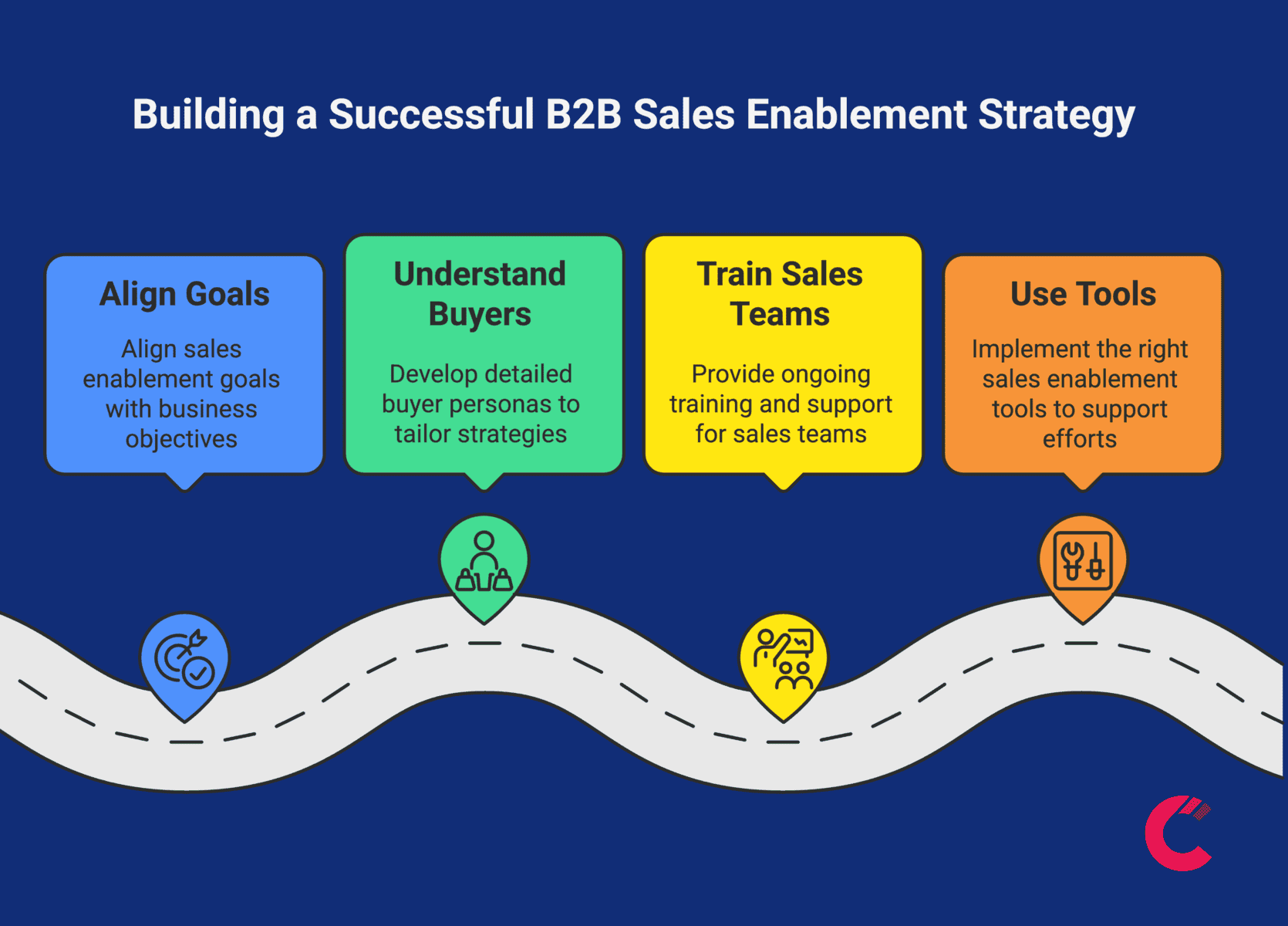
A winning B2B sales enablement strategy doesn’t happen by accident—it’s built step by step, aligning your company’s goals, understanding your buyers, and providing the right tools and training for your sales team. Let’s break it down into actionable steps that you can follow.
Step 1: Align Sales Enablement Goals with Business Objectives
Every strategy starts with knowing where you’re headed. Ask yourself: What does your company need most right now?
Whether it’s increasing revenue, reducing sales cycle length, or improving customer retention, your sales enablement strategy should be tied directly to these goals.
- Actionable Tip: Align enablement goals with key performance indicators (KPIs). For example, if your objective is to shorten sales cycles, track metrics like average deal duration or time spent in each pipeline stage.
Why It Matters: Clear alignment ensures that your enablement efforts directly contribute to the company’s success. When sales teams understand how their work impacts the big picture, it motivates them to perform better.
Step 2: Know Your Buyers
Your sales strategy is only as strong as your understanding of your buyers. Build detailed buyer personas by identifying their challenges, pain points, and motivations. This insight helps tailor content and training to what your customers need most.
- Actionable Tip: Use interviews, surveys, and analytics tools to gather data about your buyers. Equip sales reps with resources like objection-handling guides, industry-specific case studies, and solution-based product demos.
Why It Matters: A deep understanding of your buyers allows your team to craft conversations and solutions that resonate, which can significantly boost trust and conversion rates.
Step 3: Support and Train Your Sales Teams
Training isn’t just a one-time event—it’s a continuous process. Sales reps need ongoing support to stay on top of new tools, changing buyer expectations, and evolving market trends.
- Actionable Tip: Create a mix of training formats, such as in-person workshops, on-demand learning videos, and regular peer-to-peer coaching sessions. Offer certifications to encourage participation and recognize growth.
Why It Matters: Sales reps who feel confident in their skills and tools are more likely to perform well. Consistent training ensures they’re always prepared to handle challenges effectively.
Step 4: Use the Right Sales Enablement Tools
The tools you choose can make or break your strategy. Each category of tools plays a specific role in supporting your sales team and driving results.
Below are the most essential categories and the top tools in each:
1. Learning Management Systems (LMS)
LMS platforms provide structured, centralized training programs for sales reps, ensuring consistent learning across teams.
- Top Tools:
- SAP Litmos: Known for its user-friendly design and easy integration with other platforms.
- Docebo: Uses AI to personalize training paths for individual sales reps.
- TalentLMS: Affordable and customizable, making it a go-to for small to mid-sized teams.
2. Customer Relationship Management (CRM) Software
CRM tools help sales reps manage buyer interactions, track pipelines, and analyze customer data for better decision-making.
- Top Tools:
- Salesforce: A robust platform with endless customization options and integrations.
- HubSpot CRM: Free and easy to use, ideal for smaller teams or businesses just starting with CRM systems.
- Zoho CRM: An affordable yet powerful CRM with AI-driven insights for lead prioritization.
3. Sales Enablement Software
These platforms focus on delivering the right resources, content, and training to sales teams when they need it.
- Top Tools:
- Seismic: Provides advanced content management and analytics to streamline sales efforts.
- Highspot: Combines content delivery with training and coaching tools, all within a user-friendly interface.
- Showpad: Known for its content management and interactive training features, making it a comprehensive enablement tool.
4. Analytics and Reporting Tools
Analytics tools provide valuable insights into buyer behavior, sales performance, and overall strategy effectiveness.
- Top Tools:
- Tableau: A powerful platform for creating interactive dashboards and analyzing trends.
- Microsoft Power BI: Affordable and great for visualizing data across multiple sales metrics.
- Clari: Focused on sales-specific insights, like pipeline health and revenue forecasting.
5. Competitive Intelligence Tools
These tools monitor competitors’ strategies, helping your sales team stay ahead in a competitive market.
- Top Tools:
- Competitors App: Tracks competitors’ website updates, ad campaigns, and social media activity to inform your strategy.
- Crayon: Offers real-time updates and curated insights on competitor movements.
- Klue: Provides competitive data alongside actionable recommendations for sales teams.
Best Practices for Sales Enablement in B2B
Building an effective B2B sales enablement strategy doesn’t stop with tools and processes. To ensure your efforts drive measurable results, you need to follow proven best practices that align with your team’s goals and challenges.
Below are key approaches that can elevate your sales enablement efforts.
Create Relevant Content for Every Stage of the Sales Funnel
Sales reps need access to the right content at the right time. Whether they’re addressing initial buyer curiosity or final-stage objections, having tailored materials makes all the difference.
- What to Do: Collaborate with your marketing team to create case studies, ROI calculators, whitepapers, and product demo videos that align with each stage of the buyer journey.
- Why It Works: When buyers receive content that speaks directly to their pain points, they’re more likely to engage and move forward in the sales process.
Foster Collaboration Between Teams
Sales enablement thrives when sales and marketing teams work hand-in-hand. Misalignment between these departments often leads to wasted resources and inconsistent messaging.
- What to Do: Set up regular cross-departmental meetings to align goals and share insights. Use tools like Slack or Trello to streamline collaboration.
- Why It Works: When sales and marketing share a common vision, it creates a seamless buyer experience and ensures reps have the resources they need.
Emphasize Continuous Training and Coaching
The best sales enablement programs invest in ongoing learning. Buyer behavior evolves, and your sales team must stay ahead of the curve.
- What to Do: Incorporate gamification into training, host quarterly workshops, and encourage peer-to-peer coaching. Provide bite-sized, on-demand learning resources to make training accessible.
- Why It Works: Regular coaching builds confidence and adaptability in sales reps, helping them handle a variety of buyer scenarios effectively.
Track and Analyze Key Metrics
You can’t improve what you don’t measure. Identifying the right metrics ensures your enablement efforts are delivering ROI and driving business outcomes.
- What to Track: Key metrics include sales cycle length, conversion rates, win/loss ratios, and content usage by reps.
Why It Works: Metrics provide insights into what’s working and what needs refinement, ensuring your strategy evolves to meet changing needs.
Overcoming Common Challenges in B2B Sales Enablement
Even the most well-designed sales enablement for B2B programs face hurdles. Adoption issues, poorly tailored resources, and shifting buyer behavior can all hinder your efforts. Here’s how to overcome these common challenges.
Low Adoption Rates of Tools and Resources
The Challenge: Your company invests in sales enablement tools, but sales reps don’t use them.
- How to Fix It: Focus on onboarding and user-friendly tools. Provide training sessions to show reps how these tools make their jobs easier. Collect regular feedback from your team to improve usability.
Creating Buyer-Centric Resources
The Challenge: Sales reps lack content that resonates with buyers, leading to missed opportunities.
- How to Fix It: Collaborate with your sales team to identify common buyer objections and questions. Develop content like industry-specific case studies, product comparison sheets, and solution-focused videos to address these gaps.
Navigating Changes in B2B Buying Behavior
The Challenge: Buyer expectations evolve, and sales teams struggle to keep up.
How to Fix It: Stay ahead by monitoring market trends and conducting regular buyer persona updates. Use data-driven tools like CRM platforms and analytics software to understand buyer needs in real-time.
How to Measure the Success of Your B2B Sales Enablement Strategy

Measuring the right metrics is essential to understanding the impact of your B2B sales enablement strategy. Below are the key metrics you should track:
- Content Usage Rates: Monitor which sales resources are being used most frequently and how effective they are in closing deals.
- Sales Productivity: Track how efficiently your reps are moving prospects through the pipeline and closing deals.
- Customer Acquisition Costs (CAC): Assess whether your enablement efforts are reducing the cost of acquiring new customers.
- Win/Loss Ratios: Compare the number of deals won versus those lost to evaluate the overall success of your team.
- Sales Cycle Length: Measure the time it takes to move a prospect from initial contact to closing a deal.
- Revenue Growth: Track overall revenue increases directly attributed to sales enablement initiatives.
- Training Completion Rates: Ensure that your team is completing ongoing training programs and applying the knowledge effectively.
FAQ on B2B Sales Enablement
What are the best practices for sales enablement?
- Create buyer-specific content for every stage of the sales funnel.
- Foster strong collaboration between sales and marketing teams.
- Continuously train and coach your sales reps to adapt to market changes.
- Use metrics like sales cycle length, win rates, and content usage to measure success.
What tools should I use for sales enablement in B2B?
- Learning Management Systems (LMS): For structured and scalable training (e.g., SAP Litmos, Docebo).
- CRM Platforms: To manage customer interactions and sales pipelines (e.g., Salesforce, HubSpot).
- Sales Enablement Software: For content delivery and performance tracking (e.g., Seismic, Highspot).
- Analytics Tools: To track key metrics and buyer behaviors (e.g., Tableau, Power BI).
- Competitive Intelligence Tools: To monitor competitors and refine strategies (e.g., Competitors App, Crayon).
How can I align marketing and sales for better results?
- Schedule regular alignment meetings to ensure both teams share common goals.
- Use collaborative tools like Slack or Trello to streamline communication.
- Create shared KPIs that tie marketing efforts to sales outcomes, such as lead conversion rates or deal closures.
How do I overcome challenges in adopting sales enablement strategies?
- Start with tools that are user-friendly and easy to integrate into your existing workflows.
- Provide training to ensure sales reps understand the value and functionality of these tools.
- Regularly gather feedback from your team to identify pain points and refine your enablement efforts.
